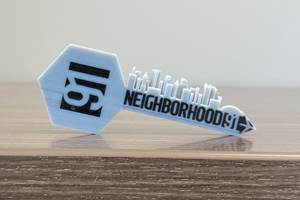3D-Printed Tools Are in Production at Falcon Jet
High part variability and low volume make 3D-printed tooling the right fit for Falcon Jet components.
Stratasys, a manufacturer of direct digital manufacturing and rapid prototyping systems using Fused Deposition Modeling (FDM) technology for producing parts and tools, is working with many customers on both part and AM tooling concepts and materials, among them Dassault Falcon Jet. Tim Schniepp, director of Composite Tooling Solutions at Stratasys with extensive aerospace experience, recently introduced me to Bastien Carel and Gregory Hilbert of Falcon Jet’s composites engineering team located at Falcon Jet’s completion center in Little Rock, Arkansas, where the company’s business jets undergo final assembly, including wiring, painting and installation of interiors. Fifty to 70 aircraft undergo completion per year at the Little Rock facility.
First, a little background on Falcon Jet: This venerable French aviation company, which began in 1916 and just celebrated its centenary, was founded by aeronautical engineer Marcel Bloch (later known as Marcel Dassault), who first developed the two-bladed Éclair propeller and founded the Societe d’Etudes Aeronautiques (SEA) to build planes for France in World War I. Later, Bloch’s company designed and built airliners for Air France, prior to World War II. The company grew tremendously between 1945 and 1975, and was responsible for the Mirage and Mystère combat fighter jets as well as French civil aircraft. Falcon Jet is one of the leaders in the business jet segment, with the Dassault Falcon 20 making its first flight in 1963. Today the company is known for its “heavy” business jets, among the largest in the bizjet market. Notably, Marcel Dassault and his engineers helped develop computer-aided design tools for the design of the company’s aircraft, and that ultimately led to CATIA and the spinoff of software company Dassault Systèmes.
Carel and Hilbert report that they are designing and developing large tools, up to 4.6 meters in length, for production of honeycomb-cored composite interior fittings, including flat and curved panels, bulkheads, and aircraft lavatory wall sections. Tools are 3D printed using a Stratasys Fortus 900mc, the largest production printer currently offered by Stratasys. Material is Ultem 1010 polyetherimide (PEI), with a Tg of 420°F; raw materials are supplied by SABIC to Stratasys to produce the final FDM filament. The tools will be produced in segments, joined in a tongue-in-groove manner and bonded with an epoxy, typically with a product such as Henkel’s EA9394. Says Carel, “We are trying a near-net approach to minimize any issues with joining.” Falcon Jet is experimenting now with joining and post-cure machining of the tools, to achieve the finished surface requirements, as well as sealers, to ensure vacuum integrity.
The FDM tools are capable of meeting requirements for dimensional accuracy says Carel, because the composite parts are vacuum-bagged and oven-cured at 250°F. Several rounds of test part cure cycles have been carried out so far, with “no visible flaws,” report Carel and Hilbert. Testing was carried out through April, with the plan to put the 3D-printed tools into the production process after that. Why 3D printing for tooling? Carel explains, “We are in a situation with high part variability and low volume,” in which jets receive customized interior layouts according to each customer’s specs. “We’re utilizing AM tooling as a complement to more traditional tooling. It’s not a direct competition with metal tooling, but it can be more efficient in terms of time and cost.”
Stay tuned for more developments in AM tooling. Schniepp, Hilbert and Carel all agree: in the next few years, 3D printed tooling has potential to be just as robust and production-capable as similar non-metallic tooling materials.
This blog post originally appeared on compositesworld.com.
Related Content
3D Printed Titanium Replaces Aluminum for Unmanned Aircraft Wing Splice: The Cool Parts Show #72
Rapid Plasma Deposition produces the near-net-shape preform for a newly designed wing splice for remotely piloted aircraft from General Atomics. The Cool Parts Show visits Norsk Titanium, where this part is made.
Read MoreAt General Atomics, Do Unmanned Aerial Systems Reveal the Future of Aircraft Manufacturing?
The maker of the Predator and SkyGuardian remote aircraft can implement additive manufacturing more rapidly and widely than the makers of other types of planes. The role of 3D printing in current and future UAS components hints at how far AM can go to save cost and time in aircraft production and design.
Read MoreWhat Is Neighborhood 91?
With its first building completely occupied, the N91 campus is on its way to becoming an end-to-end ecosystem for production additive manufacturing. Updates from the Pittsburgh initiative.
Read MoreVideo: 5" Diameter Navy Artillery Rounds Made Through Robot Directed Energy Deposition (DED) Instead of Forging
Big Metal Additive conceives additive manufacturing production factory making hundreds of Navy projectile housings per day.
Read MoreRead Next
Postprocessing Steps and Costs for Metal 3D Printing
When your metal part is done 3D printing, you just pull it out of the machine and start using it, right? Not exactly.
Read MoreCarnegie Mellon Helps Industry, Students Prepare for a Manufacturing Future with AM and AI
Work underway at the university’s Next Manufacturing Center and Manufacturing Futures Institute is helping industrial additive manufacturers achieve success today, while applying artificial intelligence, surrogate modeling and more to solve the problems of the future.
Read More3MF File Format for Additive Manufacturing: More Than Geometry
The file format offers a less data-intensive way of recording part geometry, as well as details about build preparation, material, process and more.
Read More





















